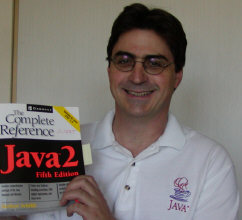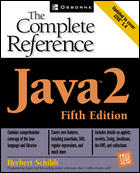
Email: java@WORDesign.com
calendar (week-by-week schedule)
 |
THOMAS ALBERT, Ph.D., is
senior technical communicator in the programmer/writer group at MDL
Information Systems, where he writes
about an object-oriented computer language. His ten years of experience documenting software
include a wide range of platforms, audiences , and industries. He holds a
doctoral degree in English and a U.C. Berkeley Extension Certificate in
Computer Information Systems. His five years of experience teaching
University Extension courses include serving as co-instructor for First
Course in Java, as well as instructor for Technical Communication in the
UNIX Environment, and and Technical Communication I and II. He has also
taught Computer Administration and Information Architecture. Email: java@WORDesign.com |

Java 2: The Complete Reference, 5th Edition
Author(s): Herbert
Schildt
ISBN: 0072224207
Softcover, 1184 pages.
(Osborne McGraw Hill, July 2002)
$49.99 US
http://shop.osborne.com/cgi-bin/osborne/0072224207.html
(Note: The publisher's web site offers free downloading of the sample code
in the book. You can purchase the book from the publisher's web site, other web
sites, and possibly at local bookstores, such as Barnes & Noble.)
Note: Lectures Notes and Homework Assignments are
subject to change until the Date of Lecture.
Week by week tally
| Week | Date | Chapters & Link to Lecture Notes | Homework due the following Sunday at 10 a.m. | Exams |
| 1 | 17 March | 1: The Genesis of Java | Download the 1.4 SKD, get it to run HelloWorld, and email the source code and output | |
| 2 | 24 March | 2: An Overview of Java | Write a program nesting if and for | |
| 3 | 31 March | 3: Data Types, Variables, and Arrays | Write a program that converts to and from the metric system | |
| 4 | 07 April | 4: Operators | Write a program that calculates how many of which coins to return as change | |
| 5 | 14 April | 5: Control Statements | Write a program with nested control statements | MIDTERM |
| 6 | 21 April | 6: Introducing Classes | Design a set of classes for a university library system | |
| 7 | 28 April | 7: A Closer Look at Methods and Classes | Write a program that exercises the Java features we discussed in the lecture | [students receive midterm grades] |
| 8 | 05 May | 8: Inheritance and Applets | Write a simple applet that works with shapes | |
| 9 | 12 May | 9: Packages, Interfaces, and Exception Handling | Study for final | |
| 10 | 19 May | Final exam (and javadoc demonstration) | FINAL |
http://www.unex.berkeley.edu/cat/306720.html
First Course in Java
X429.9 (2 semester units in EECS)
This is an introductory Java course for nonprogrammers who want to become
programmers eventually. Java uses syntax similar to C/C++. However, even if you
are unfamiliar with C/C++, you should be able to learn Java. The course focuses
mainly on the Java programming language using JDK 1.4, its syntax and semantics.
It covers data types, variables and constants, assignment and initialization,
relational and Boolean operators, control and flow constructs, classes and
objects, basic object-oriented programming with Java, understanding Java
applets, and graphics programming with Java.
World Wide Web pages are becoming truly interactive, with embedded applets for
content, animation, graphics, and sound. This is made possible by using Java,
with its promise of platform independence. What this means is that "write
once, run anywhere" may become a reality for software development (that is,
software written for Windows would work equally well on Macintosh, UNIX, and
other platforms, and vice versa).
On completion of this course, you should be able to write basic Java
applications and applets, and you should be prepared to undertake advanced
courses in Java. Enrollment is limited.
| Grade | Score (in %) |
| A | 90% -100% |
| B | 80% - 89% |
| C | 70% - 79% |
| D | 60% - 69% |
| F | <60% |
You are responsible for your work. You do
not have to contact the instructor with a reason of absence.
If you decide to withdraw, it is your responsibility to make sure that U.C. Berkeley Extension processes your withdraw request and removes your name from the final grading form. If your name appears on the official grading form, the instructor will assign you the grade you earned at the end of the five weeks.
The mid-term and final exam must be each studentís individual work without
the help of others, books, or notes.
If you cheat, you fail that exam.
The instructor prefers not to accept floppy disks because of the risks of a computer virus.
In general, the instructor request that students submit each homework solution
as plain text with the source code and sample output.
Do NOT email executables or attachments of any kind.
Please verify the quality of your work before you submit it.
The email body should have a header (see description below), your source
code, and sample output.
The email header should follow this format:
Download Sun's JDK (Java Development Kit) for your computer's platform:
You will need to compile and run your Java source code, and the instructor supports this official JDK.
For this First Course in Java, we recommend that you write your source code using a text editor you like. Some text editors add color to your source code to indicate comments, keywords, etc.
There are integrated development environments (IDEs) with sophisticated
features, but the instructor does not recommend them for the first course
because gaining
familiarity with a new tool costs time and can distract the student from the
fundamental language concepts. The instructor lists some IDEs for your information only.
last updated: 16 March 2003
Copyright © Feb 2002 granted to the Regents of the University of California